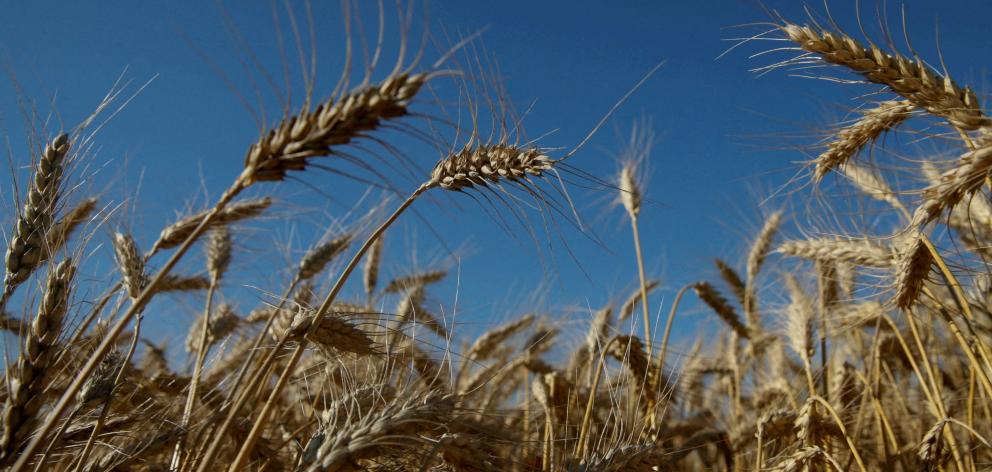United Nations Secretary-General Antonio Guterres says he is in "intense contact" with Russia, Ukraine, Turkey, the United States and the European Union in an effort to restore Ukrainian grain export as a global food crisis worsens.
"I am hopeful, but there is still a way to go," said Guterres, who visited Moscow and Kyiv late last month. "The complex security, economic and financial implications require goodwill on all sides."
Addressing a food security meeting at the UN hosted by U.S. Secretary of State Antony Blinken on Wednesday, Guterres appealed to Russia to allow "the safe and secure export of grain stored in Ukrainian ports" and for Russian food and fertilizers to "have full and unrestricted access to world markets."
Russia's war in Ukraine has caused global prices for grains, cooking oils, fuel and fertiliser to soar, and Guterres warned this will worsen food, energy and economic crises in poor countries.
"It threatens to tip tens of millions of people over the edge into food insecurity, followed by malnutrition, mass hunger and famine, in a crisis that could last for years," Guterres said.
Ukraine used to export most of its goods through seaports but since Russia's February 24 invasion, it has been forced to export by train or via its small Danube River ports.
UN food chief David Beasley appealed to Russian President Vladimir Putin: "If you have any heart at all, please open these ports."
Beasley heads the World Food Programme, which feeds some 125 million people and buys 50% of its grain from Ukraine.
"This is not just about Ukraine. This is about the poorest of the poor who are on the brink of starvation as we speak," Beasley said.
Russia and Ukraine together account for nearly a third of global wheat supplies. Ukraine is also a major exporter of corn, barley, sunflower oil and rapeseed oil, while Russia and Belarus - which has backed Moscow in its war in Ukraine - account for more than 40% of global exports of potash, a crop nutrient.

'Prepared to do our share'
Blinken said Russia must be compelled to create corridors so that food and other vital supplies can safely leave Ukraine by land or sea.
"There are an estimated 22 million tons of grain sitting in silos in Ukraine right now. Food that could immediately go toward helping those in need if it can simply get out of the country," Blinken said.
The United Nations has said 36 countries count on Russia and Ukraine for more than half of their wheat imports, including some of the poorest and most vulnerable in the world, including Lebanon, Syria, Yemen, Somalia and Democratic Republic of Congo.
Guterres spoke with Russia's first deputy Prime Minister Andrei Belousov on Tuesday about Russian exports of fertilisers and grains, said Russia's UN Ambassador Vassily Nebenzia.
"The discussions, as far as I know, went well and positive," Nebenzia told reporters on Wednesday, but he signalled that Ukrainian access to international markets was a separate issue.
"We are prepared to do our share. The Ukrainian grain market access, that's another thing," Nebenzia said.
Nebenzia said that while there were no direct sanctions on Russian fertilizers or grains, there had been a chilling effect on shipping, insurance and banking after the United States and others began punishing Russia over what Moscow calls a "special military operation" in Ukraine.
Blinken said it was "false" to blame sanctions because the United States had created exceptions and was working to ensure measures imposed by Washington "are not preventing food or fertiliser from leaving Russia or anywhere else."

Why are food prices going up?
Global food prices started to rise in mid-2020 when businesses shut down due to the Covid-19 pandemic, straining supply chains. Farmers dumped out milk and let fruits and vegetables rot due to a lack of available truckers to transport goods to supermarkets, where prices spiked as consumers stockpiled food. A shortage of migrant labour as lockdowns restricted movement impacted crops worldwide.
Since then, there have been problems with key crops in many parts of the world. Brazil, the world's top soybean exporter, suffered from severe drought in 2021. China's wheat crop has been among the worst ever this year. Concerns about food security, heightened during the pandemic, have led some countries to hoard staples to ward off future shortages, limiting supplies on the global market.
Russia's invasion of Ukraine in February dramatically worsened the outlook for food prices. The UN food agency said prices hit an all-time record in February and again in March. Russia and Ukraine account for nearly a third of global wheat and barley, and two-thirds of the world's export of sunflower oil used for cooking. Ukraine is the world's No 4 corn exporter. The conflict has damaged Ukraine's ports and agricultural infrastructure and that is likely to limit the country's agricultural production for years.
Some buyers are avoiding buying grains from Russia due to Western sanctions. Indonesia banned most exports of palm oil in late April to ensure domestic supplies of cooking oil, cutting off supplies from the world's largest producer of the edible oil used in everything from cakes to margarine.
What food prices are rising the most?
Throughout the pandemic, high vegetable oil prices have helped drive up broader food costs. Cereal prices also hit a record in March, a result of limited shipments of corn and wheat during the Ukraine war.
Dairy and meat prices reached a record in April, according to the UN food agency, reflecting continually increasing global demand for protein and high prices for animal feed - mainly corn and soybeans. In addition, bird flu in Europe and North America impacted egg and poultry prices.
In US inflation data for March, the index for meats, poultry, fish and eggs increased 14% from a year ago while beef rose 16%.
When will food prices come down?
It is hard to say, given that agricultural production depends on hard-to-predict factors like weather. UN Secretary-General Antonio Guterres said in early May the problem of global food security could not be solved without restoring Ukrainian agricultural production and Russian food and fertiliser output to the world market.
The World Bank forecasts wheat prices could rise more than 40% in 2022. The bank expects agricultural prices to fall in 2023 versus 2022. But that depends on increased crop supplies from Argentina, Brazil and the United States - by no means guaranteed.
The sharp rise in fertiliser prices, as countries avoid buying from major producers Russia and its ally Belarus, could discourage farmers from applying adequate crop nutrients to their fields. That could bring down yields and result in lower production, prolonging the crisis. As the climate warms, extreme weather is becoming more common - posing another risk to crop production.
Who is most affected?
Food prices in March accounted for the greatest share of US inflation since 1981, according to Fitch Ratings, while shop prices in Britain surged in April at the fastest rate in more than a decade. But the people most impacted by higher food prices live in the developing world, where a larger percentage of incomes is spent on food.
The Global Network Against Food Crises, set up by the United Nations and the European Union, said in an annual report that Russia's invasion of Ukraine poses serious risks to global food security, especially in countries facing a food crisis including Afghanistan, Ethiopia, Haiti, Somalia, South Sudan, Syria and Yemen.












